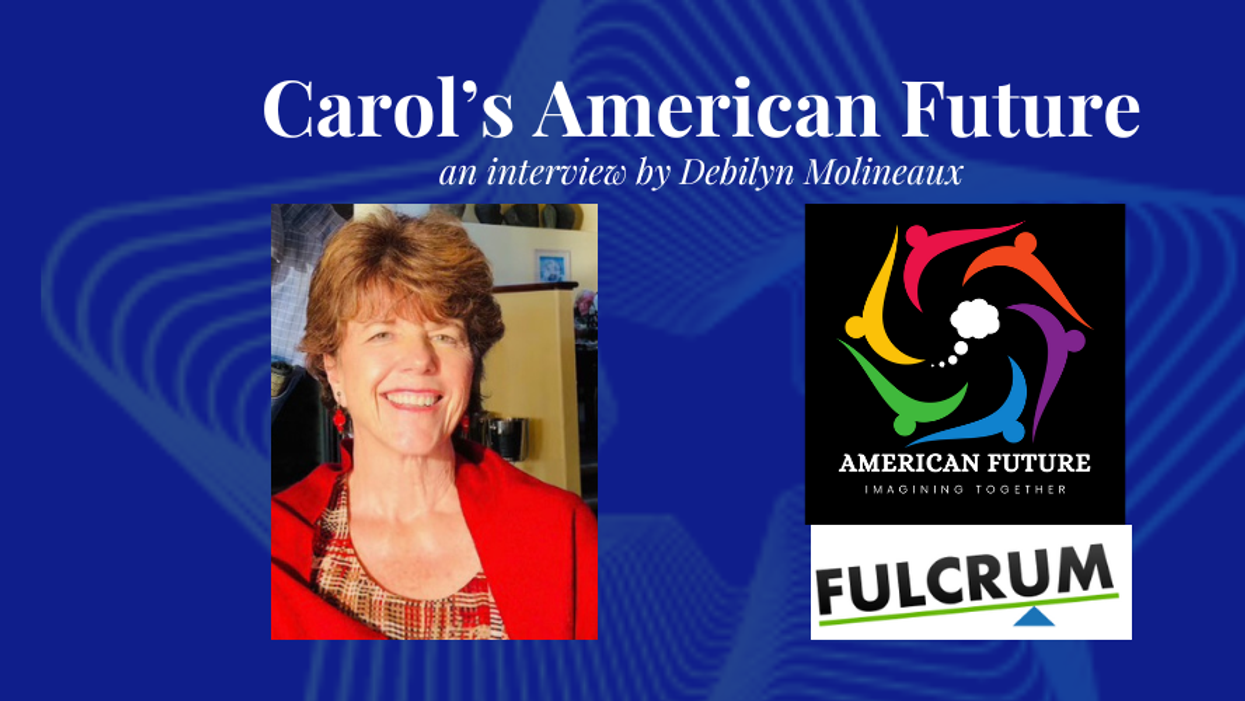This is part of a weekly series of interviews by Debilyn Molineaux, project director for AmericanFuture.US. The project's mission is to help everyday Americans to imagine a better future for themselves, and together we’ll write the next chapter of the United States of America.
Carol Courcy lives in California and is decidedly not retiring from her long career in executive coaching. She was a mentor-coach to Debilyn over 20 years ago. The initial interview took place Oct. 16, 2023, with additional questions answered by email. It has been lightly edited for clarity.
Debilyn Molineaux: We are going to time travel today – within your current life. How far would you like to imagine together? We recommend somewhere between two and 20 years. What sounds right for you?
Carol Courcy: Eight years.
DM: Let’s take a few deep breaths as the time machine takes us to this imagined future. I would like you to observe yourself there and respond to these questions. Where are you in 2031?
CC: Paul and I are living in a retirement facility, not in California. My thing is I really want green and beauty. We can find that more in other states. California is also so expensive. I imagine we’ll be walking, but done with hiking, socializing, etc. I’ll be 84 years old. I imagine myself being more at-home, but not big traveling. Maybe road trips.
DM: What will you be most proud of?
CC: I’m really proud of creating this idea of emotional agility and having it spread. Someone else wrote a book on it, based on my work. This body of work is something that spread and I didn’t have to lead the effort. It spread very naturally, like “oh, what an idea!” And it’s useful. Another thing that I’m proud of is creating a reputation of being respected, in a small pond. I like being invited versus all the chasing like earlier in my career and coaching practice when I had to say yes when I didn’t want to. I know I’m a great coach for some people. And that is plenty for me, professionally. Personally, I have a really good marriage.
DM: How will you spend your day in 2031?
CC: There’s always movement of some sort, whether it’s walking or yoga. It’s the most important thing we do every day, some sort of exercise. I’m eating healthy foods. I’m spending time with Paul and our friends. I’ve picked an emotion to work on – currently it’s empathy and compassion. It’s because I feel so resigned and disgusted with the outside world. I’m craving the re-establishment of trust and in 2031, my world is small because that’s where I know I can trust others. I’ll continue to coach as long as I’m healthy enough to do so. Especially mentoring with a Singapore group on emotions, using my textbook. They will continue to develop and lead this work on emotions. Crossing my fingers, this is a continuation of our current life. I may add in volunteering that fills my soul a little more than what I do in 2023. Maybe less task-oriented or administrative volunteer roles. I want soul work, not just filling in. I want it to ring my chimes. Something in the restorative justice area, where there is direct impact for the people I’m working with.
DM: Have you considered working in schools? There are communities that are looking for alternatives to suspending and expelling students that use restorative justice practices.
CC: No, that’s a good idea!
DM: How will you feel, most of the time?
CC: With Paul, it is better than I ever imagined. I have deep satisfaction and joy. I didn’t have real dreams about marriage. But it’s a long, solid marriage with ups and downs. I know I married the right guy. We are committed to remaining healthy, even as we have begun losing friends to illness and dementia. Our prayer list is growing. Maintaining friendships at my age is a real challenge. Empathy will help with my resilience. It’s a necessary learning edge. Physical pain is a challenge, as is navigating our health care system. The cascade of requirements to receive treatments for a torn rotator cuff means treatment takes months. With the external world, I’m still resigned and disgusted. We estimate that the Fourth Turning still has 10 more years – looking forward to First Turning and the restoration of societal trust.
DM: What will be your three priority values?
CC: First, generosity. It has been a top value for a while. Second, authenticity. Without trying, I attract the right people to whom I can be a contribution. I want to generate transformative thinking in other people. Whether through coaching or being a really good friend. Third, be viable and resilient. There will be loss and disappointment in the future. So being able to recover, we’ll need the ability to face the coming challenges, physical and emotional, self and those you hold dear.
DM: What does the community that supports your future need to include?
CC: Instead of finding personal meaning/identity by being different, using “better than” thinking to separate us from others, this community will gain personal meaning and well-being from regular community engagement (“We act for the benefit of others”). Individuals will thrive by contributing their available time and energy to contribute to the community where they live or where they care about. It will enlarge the sense of self and benefit the community. I imagine a whole network of groups, causes, places who need individual contributors. Maybe a “volunteer” corps to help match talents, capacity and time availability with contributing community needs? Whether it’s one hour a month or more from your own home or out with others, people are engaged with each other, making the community better.
DM: Is there anything you can do today or in the near future to influence or co-create the community that will support you in 2031?
CC: I don’t need to wait to do my part now. Since my 70th birthday I have embarked on the necessary mindset shift to participate in being a part of building community instead of taking from it as I age. I will continue to use my talents and abilities as long as I am able. I’m finding it creates aliveness in me by finding groups that respect and appreciate my contributions. It is up to me to take care of my health, body strength and stamina to not “burn myself out.” I find it fun to live inside a belief of acceptance + gratitude = ambitions. No effort is too small. I’ve had to change my own assumptions about aging vs. growing older (which happens daily BTW).
What keeps me alive is participating in what I care about outside of my own self. To that end I still practice my profession. ... I didn’t retire, I reduced my schedule to include play and health maintenance. I have three weekly volunteer activities. I’ve retired “the idea of retiring” and am not going to sit on my front porch. To keep that up requires exercise, healthy eating, active friendships and committing to being a part of something that keeps my brain and relationships active.



















